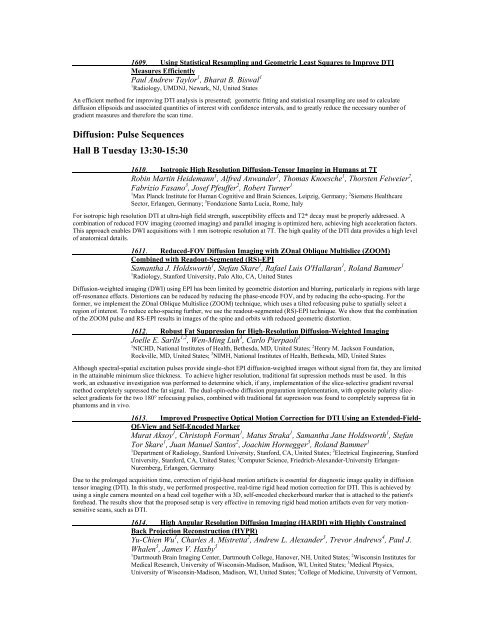Traditional Posters: Diffusion & Perfusion - ismrm
Traditional Posters: Diffusion & Perfusion - ismrm
Traditional Posters: Diffusion & Perfusion - ismrm
You also want an ePaper? Increase the reach of your titles
YUMPU automatically turns print PDFs into web optimized ePapers that Google loves.
1609. Using Statistical Resampling and Geometric Least Squares to Improve DTI<br />
Measures Efficiently<br />
Paul Andrew Taylor 1 , Bharat B. Biswal 1<br />
1 Radiology, UMDNJ, Newark, NJ, United States<br />
An efficient method for improving DTI analysis is presented; geometric fitting and statistical resampling are used to calculate<br />
diffusion ellipsoids and associated quantities of interest with confidence intervals, and to greatly reduce the necessary number of<br />
gradient measures and therefore the scan time.<br />
<strong>Diffusion</strong>: Pulse Sequences<br />
Hall B Tuesday 13:30-15:30<br />
1610. Isotropic High Resolution <strong>Diffusion</strong>-Tensor Imaging in Humans at 7T<br />
Robin Martin Heidemann 1 , Alfred Anwander 1 , Thomas Knoesche 1 , Thorsten Feiweier 2 ,<br />
Fabrizio Fasano 3 , Josef Pfeuffer 2 , Robert Turner 1<br />
1 Max Planck Institute for Human Cognitive and Brain Sciences, Leipzig, Germany; 2 Siemens Healthcare<br />
Sector, Erlangen, Germany; 3 Fondazione Santa Lucia, Rome, Italy<br />
For isotropic high resolution DTI at ultra-high field strength, susceptibility effects and T2* decay must be properly addressed. A<br />
combination of reduced FOV imaging (zoomed imaging) and parallel imaging is optimized here, achieving high acceleration factors.<br />
This approach enables DWI acquisitions with 1 mm isotropic resolution at 7T. The high quality of the DTI data provides a high level<br />
of anatomical details.<br />
1611. Reduced-FOV <strong>Diffusion</strong> Imaging with ZOnal Oblique Multislice (ZOOM)<br />
Combined with Readout-Segmented (RS)-EPI<br />
Samantha J. Holdsworth 1 , Stefan Skare 1 , Rafael Luis O'Hallaran 1 , Roland Bammer 1<br />
1 Radiology, Stanford University, Palo Alto, CA, United States<br />
<strong>Diffusion</strong>-weighted imaging (DWI) using EPI has been limited by geometric distortion and blurring, particularly in regions with large<br />
off-resonance effects. Distortions can be reduced by reducing the phase-encode FOV, and by reducing the echo-spacing. For the<br />
former, we implement the ZOnal Oblique Multislice (ZOOM) technique, which uses a tilted refocusing pulse to spatially select a<br />
region of interest. To reduce echo-spacing further, we use the readout-segmented (RS)-EPI technique. We show that the combination<br />
of the ZOOM pulse and RS-EPI results in images of the spine and orbits with reduced geometric distortion.<br />
1612. Robust Fat Suppression for High-Resolution <strong>Diffusion</strong>-Weighted Imaging<br />
Joelle E. Sarlls 1,2 , Wen-Ming Luh 3 , Carlo Pierpaoli 1<br />
1 NICHD, National Institutes of Health, Bethesda, MD, United States; 2 Henry M. Jackson Foundation,<br />
Rockville, MD, United States; 3 NIMH, National Institutes of Health, Bethesda, MD, United States<br />
Although spectral-spatial excitation pulses provide single-shot EPI diffusion-weighted images without signal from fat, they are limited<br />
in the attainable minimum slice thickness. To achieve higher resolution, traditional fat supression methods must be used. In this<br />
work, an exhaustive investigation was performed to determine which, if any, implementation of the slice-selective gradient reversal<br />
method completely supressed the fat signal. The dual-spin-echo diffusion preparation implementation, with opposite polarity sliceselect<br />
gradients for the two 180° refocusing pulses, combined with traditional fat supression was found to completely suppress fat in<br />
phantoms and in vivo.<br />
1613. Improved Prospective Optical Motion Correction for DTI Using an Extended-Field-<br />
Of-View and Self-Encoded Marker<br />
Murat Aksoy 1 , Christoph Forman 1 , Matus Straka 1 , Samantha Jane Holdsworth 1 , Stefan<br />
Tor Skare 1 , Juan Manuel Santos 2 , Joachim Hornegger 3 , Roland Bammer 1<br />
1 Department of Radiology, Stanford University, Stanford, CA, United States; 2 Electrical Engineering, Stanford<br />
University, Stanford, CA, United States; 3 Computer Science, Friedrich-Alexander-University Erlangen-<br />
Nuremberg, Erlangen, Germany<br />
Due to the prolonged acquisition time, correction of rigid-head motion artifacts is essential for diagnostic image quality in diffusion<br />
tensor imaging (DTI). In this study, we performed prospective, real-time rigid head motion correction for DTI. This is achieved by<br />
using a single camera mounted on a head coil together with a 3D, self-encoded checkerboard marker that is attached to the patient's<br />
forehead. The results show that the proposed setup is very effective in removing rigid head motion artifacts even for very motionsensitive<br />
scans, such as DTI.<br />
1614. High Angular Resolution <strong>Diffusion</strong> Imaging (HARDI) with Highly Constrained<br />
Back Projection Reconstruction (HYPR)<br />
Yu-Chien Wu 1 , Charles A. Mistretta 2 , Andrew L. Alexander 3 , Trevor Andrews 4 , Paul J.<br />
Whalen 5 , James V. Haxby 5<br />
1 Dartmouth Brain Imaging Center, Dartmouth College, Hanover, NH, United States; 2 Wisconsin Institutes for<br />
Medical Research, University of Wisconsin-Madison, Madison, WI, United States; 3 Medical Physics,<br />
University of Wisconsin-Madison, Madison, WI, United States; 4 College of Medicine, University of Vermont,















